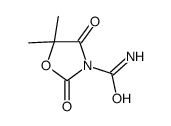Albumin, egg
Modify Date: 2024-01-06 22:42:53

Albumin, egg structure
|
Common Name | Albumin, egg | ||
|---|---|---|---|---|
| CAS Number | 9006-50-2 | Molecular Weight | 172.13900 | |
| Density | 1.426g/cm3 | Boiling Point | 251.7ºC at 760mmHg | |
| Molecular Formula | C6H8N2O4 | Melting Point | N/A | |
| MSDS | N/A | Flash Point | 106ºC | |
| Name | 5,5-Dimethyl-2,4-dioxo-1,3-oxazolidine-3-carboxamide |
|---|---|
| Synonym | More Synonyms |
| Density | 1.426g/cm3 |
|---|---|
| Boiling Point | 251.7ºC at 760mmHg |
| Molecular Formula | C6H8N2O4 |
| Molecular Weight | 172.13900 |
| Flash Point | 106ºC |
| Exact Mass | 172.04800 |
| PSA | 90.69000 |
| LogP | 0.27420 |
| Index of Refraction | 1.52 |
| Storage condition | 2-8°C |
Synonym:Alumin egg; egg albumin; egg whit Section 2 - COMPOSITION, INFORMATION ON INGREDIENTS
Risk Phrases: None Listed. Section 3 - HAZARDS IDENTIFICATION EMERGENCY OVERVIEW
Not available. Potential Health Effects Eye: Dust may cause mechanical irritation. Skin: May cause skin irritation. Low hazard for usual industrial handling. Ingestion: Ingestion of large amounts may cause gastrointestinal irritation. Expected to be a low ingestion hazard. Inhalation: May cause respiratory tract irritation. Low hazard for usual industrial handling. Chronic: No information found. Section 4 - FIRST AID MEASURES Eyes: Flush eyes with plenty of water for at least 15 minutes, occasionally lifting the upper and lower eyelids. Get medical aid. Skin: Flush skin with plenty of water for at least 15 minutes while removing contaminated clothing and shoes. Get medical aid if irritation develops or persists. Ingestion: If victim is conscious and alert, give 2-4 cupfuls of milk or water. Never give anything by mouth to an unconscious person. Get medical aid. Inhalation: Remove from exposure and move to fresh air immediately. If not breathing, give artificial respiration. If breathing is difficult, give oxygen. Get medical aid if cough or other symptoms appear. Notes to Physician: Section 5 - FIRE FIGHTING MEASURES General Information: As in any fire, wear a self-contained breathing apparatus in pressure-demand, MSHA/NIOSH (approved or equivalent), and full protective gear. This material in sufficient quantity and reduced particle size is capable of creating a dust explosion. Extinguishing Media: In case of fire, use water, dry chemical, chemical foam, or alcohol-resistant foam. Section 6 - ACCIDENTAL RELEASE MEASURES General Information: Use proper personal protective equipment as indicated in Section 8. Spills/Leaks: Sweep up, then place into a suitable container for disposal. Avoid generating dusty conditions. Section 7 - HANDLING and STORAGE Handling: Use with adequate ventilation. Avoid contact with skin and eyes. Avoid ingestion and inhalation. Storage: Keep from contact with oxidizing materials. Section 8 - EXPOSURE CONTROLS, PERSONAL PROTECTION Engineering Controls: Use adequate general or local exhaust ventilation to keep airborne concentrations below the permissible exposure limits. Exposure Limits CAS# 9006-50-2: Personal Protective Equipment Eyes: Wear appropriate protective eyeglasses or chemical safety goggles as described by OSHA's eye and face protection regulations in 29 CFR 1910.133 or European Standard EN166. Skin: Wear appropriate gloves to prevent skin exposure. Clothing: Wear appropriate protective clothing to minimize contact with skin. Respirators: Wear a NIOSH/MSHA or European Standard EN 149 approved full-facepiece airline respirator in the positive pressure mode with emergency escape provisions. Section 9 - PHYSICAL AND CHEMICAL PROPERTIES Physical State: Solid Color: yellow Odor: none reported pH: 7.6 Vapor Pressure: Negligible. Viscosity: Not available. Boiling Point: 141.8 deg F Freezing/Melting Point: 31 deg F Autoignition Temperature: Not applicable. Flash Point: Not applicable. Explosion Limits, lower: Not available. Explosion Limits, upper: Not available. Decomposition Temperature: 60 deg C Solubility in water: Soluble in water. Specific Gravity/Density: 1.0 Molecular Formula: Not available. Molecular Weight: 0 Section 10 - STABILITY AND REACTIVITY Chemical Stability: Stable under normal temperatures and pressures. Conditions to Avoid: Incompatible materials. Incompatibilities with Other Materials: Strong oxidizing agents. Hazardous Decomposition Products: Carbon monoxide, oxides of nitrogen, carbon dioxide. Hazardous Polymerization: Has not been reported. Section 11 - TOXICOLOGICAL INFORMATION RTECS#: CAS# 9006-50-2: JX2550000 LD50/LC50: CAS# 9006-50-2: Oral, rat: LD50 = 101 gm/kg. Carcinogenicity: ALBUMIN EGG - Not listed by ACGIH, IARC, or NTP. Other: See actual entry in RTECS for complete information. Section 12 - ECOLOGICAL INFORMATION Section 13 - DISPOSAL CONSIDERATIONS Products which are considered hazardous for supply are classified as Special Waste and the disposal of such chemicals is covered by regulations which may vary according to location. Contact a specialist disposal company or the local waste regulator for advice. Empty containers must be decontaminated before returning for recycling. Section 14 - TRANSPORT INFORMATION IATA Not regulated as a hazardous material. IMO Not regulated as a hazardous material. RID/ADR Not regulated as a hazardous material. Section 15 - REGULATORY INFORMATION European/International Regulations European Labeling in Accordance with EC Directives Hazard Symbols: Not available. Risk Phrases: Safety Phrases: WGK (Water Danger/Protection) CAS# 9006-50-2: No information available. Canada CAS# 9006-50-2 is listed on Canada's NDSL List. CAS# 9006-50-2 is not listed on Canada's Ingredient Disclosure List. US FEDERAL TSCA CAS# 9006-50-2 is listed on the TSCA inventory. SECTION 16 - ADDITIONAL INFORMATION N/A |
CHEMICAL IDENTIFICATION
HEALTH HAZARD DATAACUTE TOXICITY DATA
|
| Hazard Codes | T: Toxic; |
|---|---|
| Risk Phrases | R20/22 |
| Safety Phrases | 53-26-36/37/39-45 |
| tridodeoylamine |